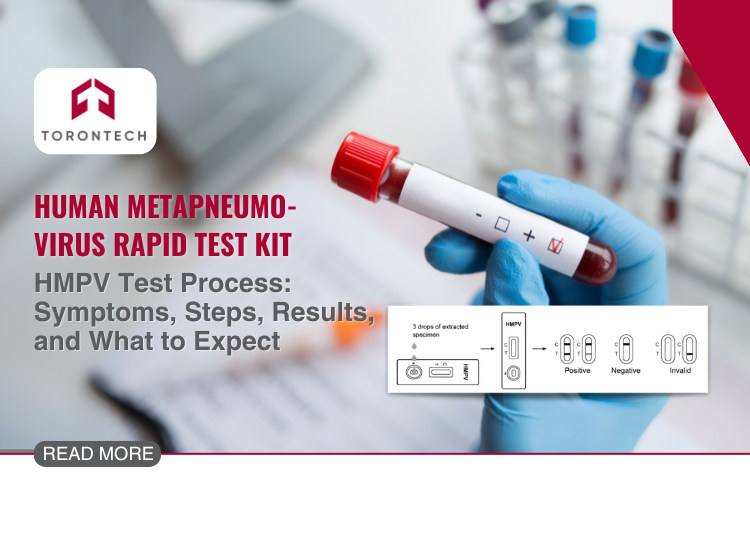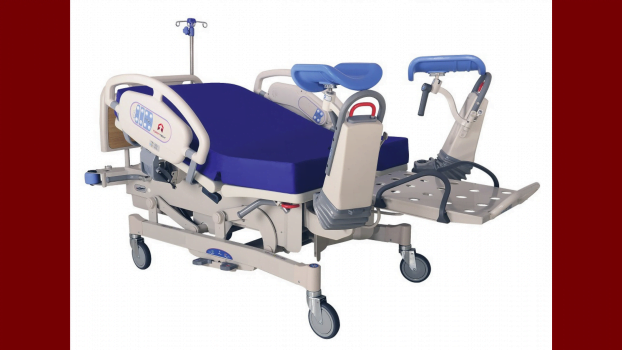Human Metapneumovirus (HMPV) is currently seeing a notable rise in cases across various parts of the world. During the week of December 16 to 22, 2024, HMPV accounted for 6.2% of positive respiratory illness tests and 5.4% of hospitalizations related to respiratory issues in the country in China
As a result, the importance of the HMPV test in diagnosing and managing this virus has become increasingly evident, especially for healthcare facilities aiming to control its spread effectively. But how do you know if someone has HMPV? This article explains everything you need to know about the test, its process, and what the results mean.
Symptoms of HMPV
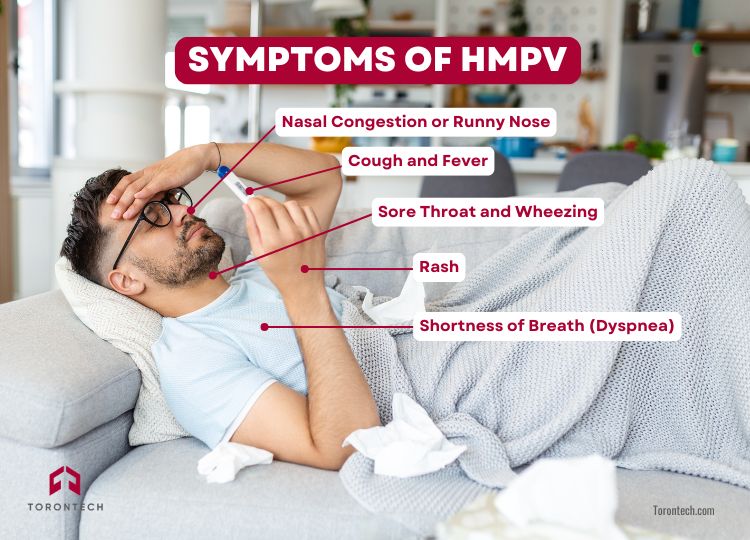
Recognizing the symptoms of Human Metapneumovirus is crucial for identifying when an HMPV test is necessary. The symptoms of HMPV often overlap with those of other respiratory infections, which can make accurate diagnosis challenging without proper testing.
You may ask, “How do you know if you have HMPV?” These symptoms can serve as a reference:
Common Symptoms
- Cough and Fever: These are the most frequently reported symptoms, often appearing early in the infection.
- Nasal Congestion or Runny Nose: Many patients experience a stuffy or runny nose, typical of upper respiratory infections.
- Shortness of Breath (Dyspnea): Difficulty breathing, especially in severe cases, is a hallmark of HMPV.
- Sore Throat and Wheezing: Additional symptoms that may accompany the infection.
- Rash: Though less common, skin rashes may occur in some cases.
Severe Cases
HMPV infections can progress to more serious respiratory conditions like bronchitis or HMPV pneumonia, particularly in at-risk individuals. The infection typically has an incubation period of 3 to 6 days, with symptoms potentially lasting anywhere from several days to weeks, depending on severity.
Early detection and the use of an HMPV testing are key to managing the infection and preventing complications. As the symptoms often mimic other respiratory illnesses, the HMPV test helps ensure proper diagnosis and timely treatment, which can significantly improve outcomes for those affected.
When Should You Get Tested?
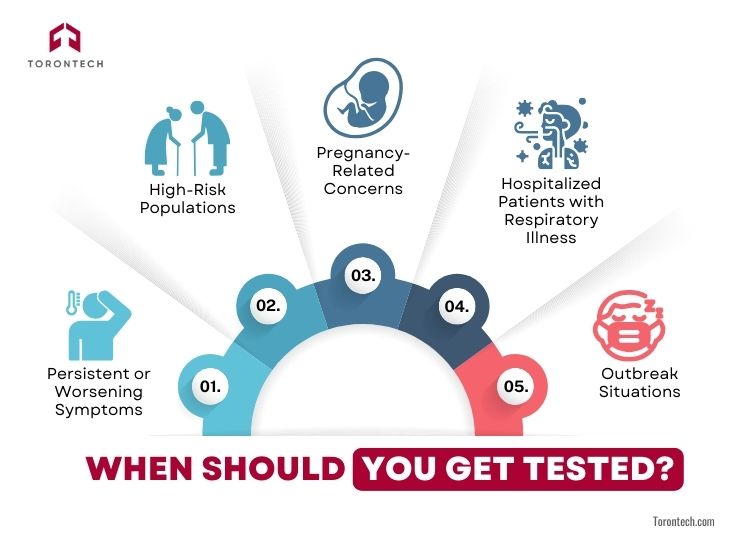
Deciding when to administer an HMPV test is crucial for timely and effective diagnosis. Because hmpv virus shares symptoms with other respiratory viruses like RSV and influenza, identifying key scenarios that warrant testing is essential for healthcare providers.
When Testing is Recommended
1. Persistent or Worsening Symptoms
Individuals experiencing prolonged respiratory symptoms such as fever, cough, nasal congestion, or shortness of breath should consider an HMPV test, especially when other illnesses have been ruled out.
2. High-Risk Populations:
Testing is particularly important for vulnerable groups, including:
- Young Children: At greater risk for severe infections like bronchitis or pneumonia.
- Older Adults: More likely to develop complications due to weakened immunity.
- Immunocompromised Patients: Likely to experience severe illness and prolonged recovery.
3. Pregnancy-Related Concerns
Pregnant individuals presenting with respiratory symptoms may benefit from testing to manage potential risks to maternal and fetal health (Clinical Significance of HMPV Detection, 2023).
4. Hospitalized Patients with Respiratory Illness
In critically ill patients, distinguishing HMPV infection from other causes of respiratory distress is critical for guiding treatment decisions.
5. Outbreak Situations
Testing is essential during community or healthcare-related outbreaks to monitor and control the spread of HMPV effectively.
Why Early Testing Matters
The symptoms of HMPV can escalate quickly, leading to severe complications like HMPV pneumonia, especially in high-risk individuals. Early detection through an HMPV test ensures timely intervention, improving patient outcomes and aiding in infection control.
By recognizing these situations and prioritizing testing, healthcare facilities can better manage HMPV infections, minimizing the impact on patients and reducing the strain on medical resources.
Steps in the HMPV Test Process
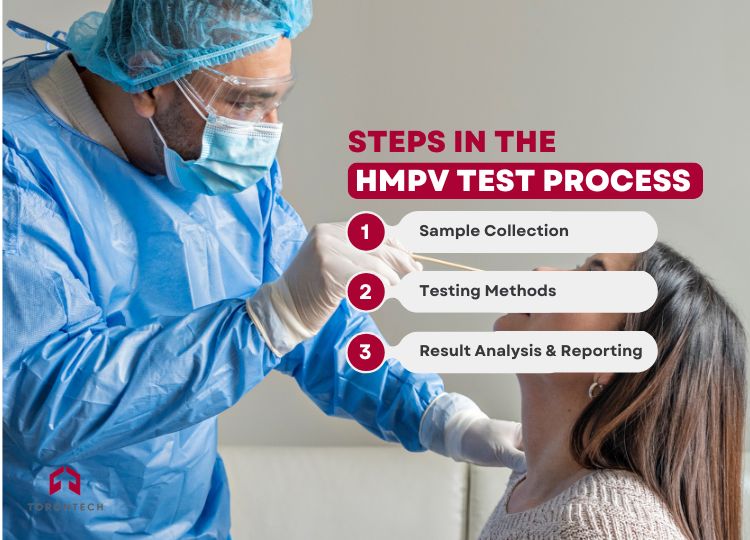
Understanding the HMPV test process is critical for healthcare providers and laboratories aiming to deliver accurate and efficient diagnoses. From sample collection to result interpretation, each step plays a vital role in identifying Human Metapneumovirus (HMPV) infections.
1. Sample Collection
The first step in the testing process involves collecting a sample, typically through:
- Nasopharyngeal Swabs: A preferred method due to its high viral yield, ensuring reliable results.
- Throat Swabs: An alternative for patients unable to undergo nasopharyngeal sampling.
Proper sample collection is essential to minimize the risk of false negatives and ensure the accuracy of subsequent testing.
2. Testing Methods
The collected sample is analyzed using one or more of the following methods:
1. HMPV Rapid Test:
- Uses immunochromatography to detect HMPV antigens.
- Provides results within 15 minutes, making it ideal for point-of-care testing.
- High accuracy (91.7% sensitivity, 99.1% specificity) ensures dependable results for timely decisions (Evaluation of a New Rapid Antigen Test, 2009).
2. RT-PCR (Reverse Transcription Polymerase Chain Reaction):
- Amplifies viral RNA to detect HMPV with high sensitivity.
- Serves as the gold standard for confirmatory testing, especially in cases where rapid tests yield inconclusive results (Feng et al., 2024).
3. RT-qPCR (Quantitative RT-PCR)
- Offers additional insights into viral load, helping to assess the severity of infection.
3. Result Analysis and Reporting
Once the sample is tested:
- Positive Results: Indicate active HMPV infection, requiring appropriate clinical management.
- Negative Results: Suggest no active infection but may require follow-up testing if symptoms persist.
Understanding Test Results with the HMPV Rapid Test
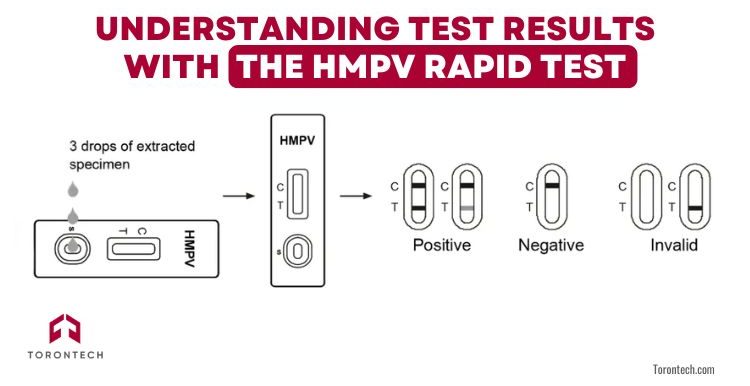
The HMPV Rapid Test is designed to simplify the diagnostic process while ensuring accuracy and efficiency. Its convenient procedure and easy-to-read results make it an ideal solution for healthcare providers handling HMPV cases.
A. Convenient and Simple Testing Procedure
Using the HMPV Rapid Test is straightforward:
- Collect the patient’s sample using a nasopharyngeal swab.
- Add 3 drops of the extracted specimen into the test cassette’s sample port.
- Wait for the result, which appears within 15 minutes, ensuring quick decision-making for patient care.
This simple process reduces the need for extensive training, making it suitable for busy healthcare settings or point-of-care diagnostics.
Easy-to-Interpret Results
The HMPV Rapid Test delivers clear and reliable results:
- Positive Result: Both the “C” (Control) and “T” (Test) lines appear, confirming the presence of HMPV.
- Negative Result: Only the “C” line appears, indicating no detectable HMPV.
- Invalid Result: If no “C” line appears, the test must be repeated with a new cassette.
The intuitive design minimizes interpretation errors, ensuring that healthcare professionals can quickly and confidently identify the infection status.
With its user-friendly design, rapid turnaround time, and high accuracy, the HMPV Rapid Test is a reliable tool for managing the rising demand for HMPV diagnostics. Equip your facility with a diagnostic solution that supports effective patient care while streamlining workflows.
The Role of Vaccines and Future Care
While diagnostic tools like the HMPV Rapid Test provide critical support for detecting HMPV infections, long-term management and prevention also depend on advancements in treatment and vaccine development. These developments promise to transform how HMPV infections are controlled and mitigated in the future.
1. Vaccines in Development
Currently, there are no commercially available vaccines for HMPV, but research is progressing rapidly. A notable example is the IVX-A12 vaccine, which is in phase II clinical trials (MDPI Microorganisms, 2025).
If successful, this vaccine could reduce the prevalence of HMPV infections, particularly in high-risk populations such as children, older adults, and immunocompromised individuals. Vaccination would complement testing efforts by preventing severe cases and decreasing transmission rates.
2. Testing’s Continued Importance
Even with the development of vaccines, the role of testing will remain critical for:
- Monitoring Outbreaks: Identifying infections in vaccinated and unvaccinated populations.
- Guiding Treatment Decisions: Early diagnosis with tools like the HMPV Rapid Test ensures timely care for symptomatic individuals, especially in high-risk cases.
- Public Health Data Collection: Accurate diagnostics provide valuable data for understanding HMPV’s spread and effectiveness of vaccination programs.
Final Thoughts
Addressing the global rise of HMPV infections requires both cutting-edge diagnostics and advancements in prevention strategies. The tools such as HMPV Rapid Test Kit enables healthcare providers to diagnose cases quickly and accurately, ensuring patients receive timely care. Its efficiency and reliability make it a valuable tool for healthcare facilities navigating the challenges of respiratory diagnostics.
As research into vaccines like IVX-A12 progresses, diagnostic tools will continue to play a pivotal role in controlling infections and monitoring vaccination effectiveness. By adopting innovative solutions like the HMPV Rapid Test, healthcare facilities can better serve patients while contributing to broader public health goals.
References
- Feng, Y., He, T., Zhang, B., Yuan, H., & Zhou, Y. (2024). Epidemiology and diagnosis technologies of human metapneumovirus in China: A mini review. Virology Journal.
- MDPI Microorganisms. (2025). The Silent Threat of Human Metapneumovirus: Clinical Challenges and Therapeutic Opportunities.
- Journal of Clinical Microbiology. (2009). Evaluation of a New Rapid Antigen Test Using Immunochromatography for Detection of Human Metapneumovirus.
- PLOS ONE. (2014). Human Metapneumovirus: Insights from a Ten-Year Molecular and Epidemiological Analysis.
- Annals of Intensive Care. (2023). Clinical Significance of Human Metapneumovirus Detection in Critically Ill Patients.

